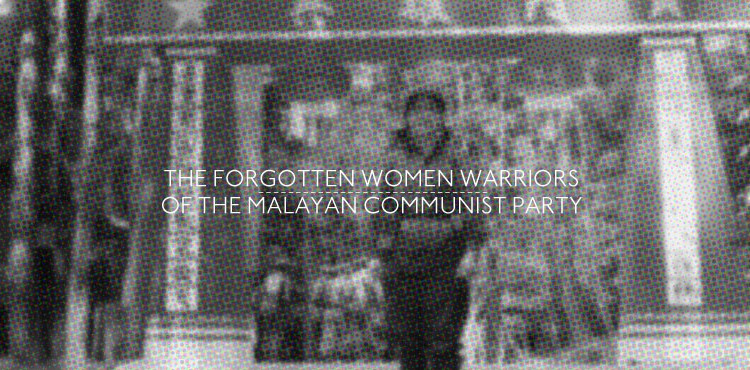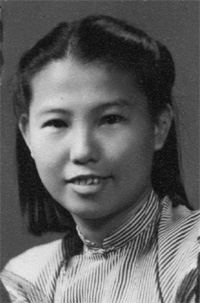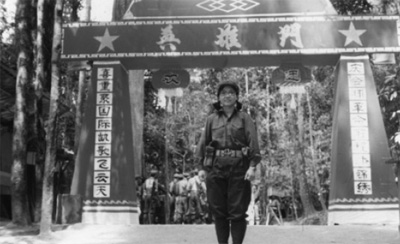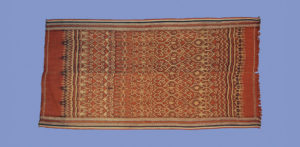
Mention communists, guerillas, freedom fighters, militants and ideologues and the images that leap to mind are invariably male. In Asia, it is no different, except there is an added bias of patriarchy and of a history that has, until recently, been constructed and then recounted by former colonial powers and their historians. After independence, new ‘autonomous’ national histories had to be created and national curricula constructed, with those not fitting into these narratives either omitted or marginalised. Adrianna Tan examines the case of the women warriors of the Malayan Communist Party.
Not surprisingly, a history – official, academic and popular – of the Malayan communists, with the Malayan Communist Party (MCP) at the core of the movement, is lacking. There is a penchant for dichotomous terms of good and evil, black and white. The conventional narrative is usually that of the ruthless Malayan Communists – typically Chinese and always male – versus the valiant and ultimately successful attempts of the colonial power and incoming national governments that saved the region from the global communist conspiracy.

A young Li Qiu: an integral female member of the party, Li Qiu represented the MCP in China. She now lives in Beijing. Photograph courtesy of CC Chin.
If there is anything certain at all about this particular part of history, it is that the version of those defeated has been as good as airbrushed out of history, or at least heavily tweaked. In fact, the communist movement in present day Singapore and Malaysia, not to forget its hinterlands in Thailand’s Muslim south, spanned the better part of the 20th century, first overlapping with the independence movements of these countries, then fighting against the post-independence governments, before petering out two decades ago when the guerillas finally laid down their arms in 1989. Now in retirement and in their seventies or even eighties, several key figures of the MCP have narrated their version of events. (1)
Daughters, mothers, wives, lovers
If it is true that the human side of the Malayan communist history is missing, this is even more so the case for the female angle. In fact, a surprising number of the MCP was female. While the exact number is not known, some put the figure as high as 30 per cent. What is known, however, is that their role was certainly significant. The women of the MCP were Chinese, Malay and Thai – born in China, Singapore, Malaysia and southern Thailand. They were commanders, leaders of civilian movements, members of the Politburo, rank and file soldiers; they were doctors, surgeons and nurses and they were in combat on the same terms as male soldiers. More importantly, they continued to be daughters, mothers, wives and lovers. They endured extreme hunger and physical and mental duress, then hunted elephants and wild boar alongside the men. They suffered terrible injuries in battle, ran, walked and carried the same heavy load as the men; and sometimes persevered when male comrades had given up. Some arrested male communists and defectors were eager to point out to their interrogators how they preferred the treatment they received in captivity to that of their occasionally “terrifying… demanding” female commanders in the MCP. (2) The women of MCP were known to be far tougher, physically and mentally, than their male counterparts, taking far more easily to the physical and mental demands of a life on the run. When captured, they rarely cracked under pressure or torture. It could be said they lived for the ideology they believed in, and took it to the grave.
Yet little is known about these women and the lives they led, except for one book of interviews and overlapping material from independent research about the MCP. Agnes Khoo’s groundbreaking “Life As the River Flows” (2004) is a collection of oral history interviews, giving a voice to the women of the MCP. But it is only a preliminary attempt at piecing together a coherent story about the women of the Malayan Communist Party. To my knowledge, no other narratives exist in either academic or popular history. Research and original material has been scarce and mostly in Chinese: the leading MCP researcher CC Chin and his counterparts have carried out meticulous research for decades, but seldom focused solely on the women. (3)
Khoo’s 16 interview partners freely discussed their lives, regrets, struggles, beliefs and hopes with the Singapore-born researcher. This preliminary narrative can hopefully open the door to a new interest in this important but often forgotten part of the contemporary history of the ‘Malay’ peninsula. It is a story about women who were invisible when they were daughters and wives in the traditional Southeast Asia of the 1930s through to the 1960s and 1970s: Invisible when they left home to live out a life in the dense forests of Malaysia and Thailand and invisible again now as they find themselves on the wrong side of history – forgotten, banished, silenced by the state and by shame. In learning about their contribution to history, historians gain an understanding of some significant themes underlying this transnational struggle; while the rest of us may find some lessons from the story of female lives led bravely, harshly and sometimes brutally.
The Malayan Communist Party was formed in 1930. It gained influence and numbers in the anti-Japanese movement from 1939 to 1945, peaked as an anti-colonial independence movement from 1948 to 1959 in the Malayan Emergency, was banished to the jungles after independence from 1959, surged during the communist wave in Indochina in the 1970s, and finally laid down their arms following the 1989 Peace Accords. Throughout these six decades, women from diverse social, cultural and ethnic backgrounds joined the struggle.
They had different motivations. Some joined to escape poverty or oppressive and sometimes violent family structures, or simply the dead-end boredom of village life. Some were highly educated intellectuals, others were illiterate. While Mandarin was the lingua franca of the MCP, the Guangxi dialect was also widely spoken, and the Malay and Southern Thai recruits spoke Malay and Thai. Some women left home in the face of family opposition, never to see family members again; others joined with their entire families.
The party lived up to the Communist archetype of being highly structured, disciplined, and organised. From the early years as a bona fide political party, to its years on the run as a capable guerilla force, the MCP’s charismatic leaders and their Chinese emphasis on exemplary behaviour won over many civilian hearts and influenced many young minds.

Surgery in the jungle: guerillas risked injury and death in the jungle, but as wanted people could not seek medical treatment. The army had its own doctors who met the medical needs of the Communists, from minor injuries to major operations – all with primitive tools in makeshift conditions. Courtesy of CC Chin
Three women of the Party
We begin by comparing three women from similar backgrounds, born in different ‘countries’. Lin Guan Ying was a senior Party member born in China in 1923, in Hui Zhou, Guangdong. She grew up in Negeri Sembilan in Malaya. Like many other overseas Chinese, Guan Ying and her family were fervently patriotic. Even before the Japanese overran Southeast Asia in 1942, many immigrant Chinese were already active in anti-Japanese resistance, either by donating money or joining resistance movements. Guan Ying’s village, the village of Yi Lang Lang, was no different – “nearly everyone… joined the resistance”; the ‘red village’ even grew food to feed the anti-Japanese movement. This same patriotism involved Guan Ying’s family in the resistance efforts; their home at Yi Lang Lang was a safe house for guerillas providing shelter and communications.

Female soldier in the breakaway group of the MCP. This small breakaway faction acknowledged the creation of Malaysia by naming themselves the Communist Party of Malaysia. They gave up arms in 1987, two years before the MCP, and were resettled in the same areas of Southern Thailand but in separate villages. Courtesy of CC Chin.
By the time she was 18, her activism had already made Guan Ying an informal member of the party; joining officially was a natural step for her and many of her contemporaries. She eventually went on to do high-level Party work in China for several decades, and also married a high-ranking Politburo member. The activism and social awareness in the Chinese schools of the day provided fertile breeding ground for future members of the party. Many, including the longtime leader of the party, Chin Peng (b. 1924), and his schoolmate Eng Ming Ching (b. 1924) – the hardy female member of the Politburo and leader of the 10th Battalion – began revolutionary activities as a direct result of the anti-Japanese resistance popular in Chinese schools in the early 1940s.
A decade after the Japanese resistance, in early 1950s Singapore, Guo Ren Luan and her peers were involved in a similarly disciplined activism, founding associations to help poor students afford school fees and buy books, forming anti-pornography movements (sic), participating in student rallies, and forming the Federation of Chinese High School Unions, among others.
In May 1954, hundreds of Chinese middle school students clashed with the colonial police regarding the unpopular introduction of compulsory conscription, resulting in 26 injured and 45 students arrested. Consequently, students like Guo Ren Luan found themselves with renewed anti-colonial sentiments and politically radicalised. She soon left home to avoid arrest and continued being active in the Malayan underground when the Federation of Chinese High School Unions was outlawed by the colonial government. Guo Ren Luan’s work as an underground activist was to instill revolutionary ideas in the village, which often included teaching literacy to women and tuition classes to children. This was followed by 13 years of self-imposed exile in Indonesia.
Not all MCP members were Malaya- or China-born. Zhu Ning was born in Thailand in 1931 into a strictly conservative Chinese family that arranged the marriage of their 15-year old daughter. Under the mental duress of a severe mother-in-law and an absent husband, Zhu Ning was miserable, trapped in the traditional Confucian family structure. After helping the guerillas for many years, she joined them in 1967 with her four children in tow. For Zhu Ning and her family the guerilla army was a route out of poverty and ‘feudalism’. Her story is echoed by many other women who joined as a means of escaping families who refused them education, wanted them married, were often steeped in abject poverty, and sometimes abused them.
The women’s work in the armed wing of the MCP had two broad aspects. Many, including rank and file female soldiers, were involved directly in combat. These women laid landmines and participated in military exercises and conflict. Others were involved in what the party called min yun huo dong (civilian mobilisation). This included anything from recruitment drives, instilling ‘progressive ideas’ in civilians, to getting civilians to provide food for the guerillas. Those women who performed min yun activities split their time between their base in the jungle with the rest of the army, and moving openly among civilians in villages, towns and cities, which was just as dangerous.
Life, love, parenthood and the present
Men and women were strictly separated in their sleeping quarters, and relationships without the permission of commanders were forbidden. Nevertheless, many fell in love and married, with the party’s official sanction, while continuing to live in the jungle. One high profile marriage included that of Eng Ming Ching (now known as Suriani Abdullah) to the Chairman of the MCP, the Malay comrade Abdullah CD (b. 1923).
The ups and downs of jungle marriages, and the party’s involvement in them, are well documented in the case of Huang Xue Ying (b. 1934) and her husband Ah Yum, a high-ranking party official. When her husband had an affair with another married comrade, party leaders immediately intervened and punished them. Whether in courtship, marriage, divorce and childbirth, the party always played a central role. Thus when Huang Xue Ying gave birth, her baby daughter was sent out of the jungle immediately to be adopted by a Thai family; the young couple was never to see their child again, a fate shared with many other guerilla parents. Others were more fortunate and could at least send their offspring to family members, though often remaining strangers to their children even after having given up armed struggle.
The Hat Yai Peace Agreement of 1989 saw the Thai and Malaysian governments successfully negotiate a peace treaty with MCP leaders. The MCP guerillas laid down their arms and were resettled in four ‘Peace Villages’ in southern Thailand, with Sukirin village housing Malay party members and the rest (Betong, Banlang, Yaha) being predominantly Chinese. A fifth village exists to house a faction that split in 1968 to form the Communist Party of Malaysia (not Malaya) and which surrendered earlier, in 1987. Most of the former guerillas are now farmers and rubber tappers, many enjoying the routines of family and parenthood for the first time in their lives. (4)
My hope is that this brief glimpse into the life and work of the women of the MCP provides enough fodder to ignite a new interest, not only in one of Asia’s forgotten wars but also in female agency in armed anti-colonial and communist struggle. It is regrettable that due to a lack of resources and perhaps also a reluctance to re-visit the ghosts of the past, the stories of prominent female personalities like Wu Rui Ai are not explored in a satisfactory manner. Eng Ming Ching a.k.a. Suriani Abdullah, tells her side of history in her memoirs, published in 2007, but until an English translation is made, only readers of Chinese and Malay can enjoy the flamboyant story of one of the party’s key female personalities. Perhaps in the near future as more work and research is carried out to explore this exciting topic of our recent history, a clearer picture can emerge from the current haziness.
Adrianna Tan
Freelance writer and photographer
Blog: www.popagandhi.com
skinnylatte@gmail.com
Notes
- For English-language accounts, see Ching Peng (2003); Chin & Hack (2004); Wong (2005).
- Interview, J. L. M. Gorrie, Oral History Centre, National Archives of Singapore.
- Cheah Boon Kheng (1987) would be the English-publishing counterpart.
- Amir Muhamad’s irreverent and impressionistic “The Last Communist” (2006) and “Village People Radio Show” (2007), banned in Malaysia, give a glimpse into the life of a Chinese and a Muslim MCP village respectively.
References
- Chin Peng. 2003. Alias Chin Peng: My Side of History, as told to Ian Ward and Norma Miraflor. Singapore: Media Masters.
- Chin, C. C. and Karl Hack (eds) 2004. Dialogues with Chin Peng: New Light on the Malayan Communist Party. Singapore: Singapore University Press.
- Kheng, Cheah Boon. 1987. Red Star over Malaya: Resistance and Social Conflict During and After the Japanese Occupation, 1941-1946. Singapore: Singapore University Press.
- Khoo, Agnes and Richard Crisp (ed) 2004. Life as the River Flows: Women in the Malayan Anti-Colonial Struggle – An Oral History of Women from Thailand, Malaysia and Singapore, as told to Agnes Khoo. Petaling Jaya, Malaysia: Strategic Information Research Development. Translated into Malay, Indonesian, Chinese.
- Wong, James Wing On. 2005. From Pacific War to Merdeka: Reminiscences of Abdullah CD, Rashid Maidin, Suriani Abdullah and Abu Samah. Petaling Jaya, Malaysia: Strategic Information Research Development.
This article was first published for the International Institute for Asian Studies. The original article can be found here. Republished with permission from Adrianna Tan.




